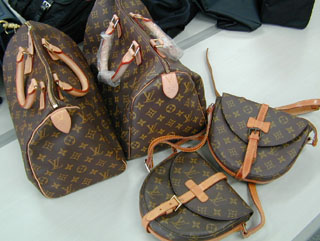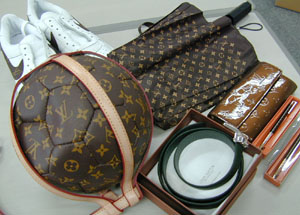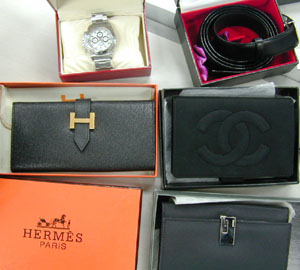Brand Name Fakes Follow the Fashion
The weekly newsroom strategy meeting had just finished up with junior reporter Junko's presentation on the sale of fake designer brand goods in Japan.
 "Oh, and one final thing before we wrap up," said the Boss. "As a part of our ongoing internal restructuring, we'll be eliminating the women's changing room on the eleventh floor and installing six vending machines."
"Oh, and one final thing before we wrap up," said the Boss. "As a part of our ongoing internal restructuring, we'll be eliminating the women's changing room on the eleventh floor and installing six vending machines."
Junko blinked twice, set down her notes, and stood at the edge of the conference room table. I tapped my cigarette on the tray in front of me. She then began to speak.
"YOU ARE GYOZA-BREATH WEASELS!!!"
"Say," said the Boss, turning to me. "When we're done here, why don't we head out and grab some gyoza? I know a good place in Shimbashi, right near the station."
"YOU CRUMBS RUN UP TABS ON BOOZE, MASSAGES, HOSTESSES, AND CIGARETTES WITH NO CONCERN FOR BUDGETS..."
"I know that place," I said, puffing once on my stick. "There's a nice Filipino hostess club just down the street."
"Sounds good," said the Boss.
"THE CHANGING ROOM IS OUR ONLY CHANCE TO GET AWAY FROM YOU ALCOHOLICS AND NOW YOU'RE TAKING IT AWAY!!!"
Junko then turned for the door.
"Did she want something?" the Boss asked.
When the World Cup bounced into Japan last year it brought with it millions of soccer enthusiasts, nearly all of whom wanted to take back with them a souvenir or two; maybe an authentic team jersey, a commemorative hat, a visor, or a t-shirt. And for those who like a hint of fashion to go with their soccer, perhaps even a Louis Vuitton soccer ball.
In his office at Tokyo Customs, a division of the Ministry of Finance located in Odaiba, Hiroji Matsuyama balances one such ball in the palm of his hand. "It's a fake," he assures.
 The ball is one of dozens of examples of originals and fakes - handbags, wallets, key rings, and watches - spread out over a table. From this selection, determining the real thing from a copy is tough, even for experts trained in the field. Zippers, stitch patterns, buckles, tags, labels, and logos match their counterparts nearly exactly. "Even I can't tell the difference," Matsuyama admits. (He knew beforehand that their single soccer ball is a fake.)
The ball is one of dozens of examples of originals and fakes - handbags, wallets, key rings, and watches - spread out over a table. From this selection, determining the real thing from a copy is tough, even for experts trained in the field. Zippers, stitch patterns, buckles, tags, labels, and logos match their counterparts nearly exactly. "Even I can't tell the difference," Matsuyama admits. (He knew beforehand that their single soccer ball is a fake.)
It is a well-known fact that Japan buys up one-third of the world's designer brand products. But maybe what is not so apparent is that the market for imitations of these goods is proportionally as staggering. Given all the potential money at stake, and the ever-changing targets and methods of the fakers, customs workers and the manufacturers of the originals alike are constantly battling to keep up and keep copies out of the marketplace.
"It's a case of following the fashion," Matsuyama says of the trends in what is copied. He explains this by saying that as Tiger Woods and David Duval increased in popularity in Japan, Tokyo Customs started seizing white sneakers decorated with brown Nike swooshes enhanced with Louis Vuitton logos. The same was true in the months leading up to the World Cup where over 60,000 soccer-related counterfeit items were seized at various airports, seaports, and post offices. Likewise, with Louis Vuitton brand goods becoming an extremely popular fashion accessory among Japanese office ladies in recent years, Louis Vuitton items - all of them - are the most copied, he says.
Brand name designer goods are, of course, not the only things counterfeited in Japan. Passports, CDs, and currency are all copied and distributed as originals. But when it comes to notoriety, brand goods hold the highest profile.
The reason is that these goods are more than a product or commodity; they are symbols of luxury and class. With Japan being an egalitarian society - more or less anyway - enjoying a high standard of living, and the thinking for many Japanese women being that you are only as good as your handbag, the demand for the Prada triangle and the Louis Vuitton interlocking L and V pattern becomes larger than perhaps anywhere on earth. In 2001, consumer demand for the products of the 42 foreign brand companies operating in Japan increased by a recession-be-damned 40 percent over the year before, according to Teikoku Databank Ltd.
 Originals of these goods are in such demand that they can become the nation's second currency. Often is told are stories of a bar hostess requesting three identical handbags from three different customers. She will then sell two of the three to a secondhand shop for cash, keeping the third to parade in front of her three clients. And when handbag-hungry high school girls engaging in prostitution are so common as to generally not even be newsworthy (unless a politician is fingered for utilizing their services), it becomes clear that the demand in Japan is uniquely high for these products - and, as a result, their associated fakes.
Originals of these goods are in such demand that they can become the nation's second currency. Often is told are stories of a bar hostess requesting three identical handbags from three different customers. She will then sell two of the three to a secondhand shop for cash, keeping the third to parade in front of her three clients. And when handbag-hungry high school girls engaging in prostitution are so common as to generally not even be newsworthy (unless a politician is fingered for utilizing their services), it becomes clear that the demand in Japan is uniquely high for these products - and, as a result, their associated fakes.
In recent years, seizures of brand copies have been soaring. Tokyo Customs reports that in 2001 the number of phony handbags bagged in Japan doubled to nearly 84,000 over the year the before. Additionally, the number of nabbed key rings increased by a factor of twenty during the same period. The source of these imitiations is primarily Korea, Hong Kong, and China.
Matsuyama notes that because the copiers produce such realistic copies, the Tokyo Customs staff are not qualified to make a determination about whether a particular good is genuine or not. Instead, when items suspected to be phony are found concealed in, for example, a shipping container at one of the various checkpoints within the Tokyo jurisdiction, representatives from the brands themselves are called in. (For the majority of the fakes, the main difference lies in the materials. For example, a fake handbag might be composed of a cheaper form of leather when compared to the real McCoy.)
Carefully overseeing the supply chain is one of the most important parts of preventing fakes, says an international watch sales representative in Tokyo (wishing that he and his company remain anonymous). Proper forecasting lowers the risk of leaving unassembled product parts in the hands of suppliers. "Just like some brands sell overstock to discounters," he says, "suppliers will dump parts if the brands do not strictly restrict them to do so."
And if those dumped parts are, say, watch casings, they could later be injected with inferior workings. The result is a fake that looks damn near real.
An estimate of the amount of money lost to the brands defies measurement, says a representative of Union de Fabricants, an organization which fights for the rights of manufacturers around the world, in a recent article appearing in the Japan Times. But for the consumer there are generally two ways of looking at the problem: either they are being duped or, rather, they are knowingly purchasing the image they want at a discount, sometimes for as little as one-tenth of the original at shops and stalls scattered through Tokyo's Shibuya and Shinjuku districts.
The watch representative says that the former is the most dangerous of the two to his business. In essence, a tricked consumer is an angry consumer. Sales via the Internet are increasingly allowing for sales of fakes of authentic products at prices slightly below the Japanese retail level.
Still, all is not entirely lost for the brands being knocked off. Imitation can have its upside, albeit small, says the watch representative. "Being 'faked' is an indication of the demand of your brand and also is a barometer on your strength in the market."
Flattery indeed.

